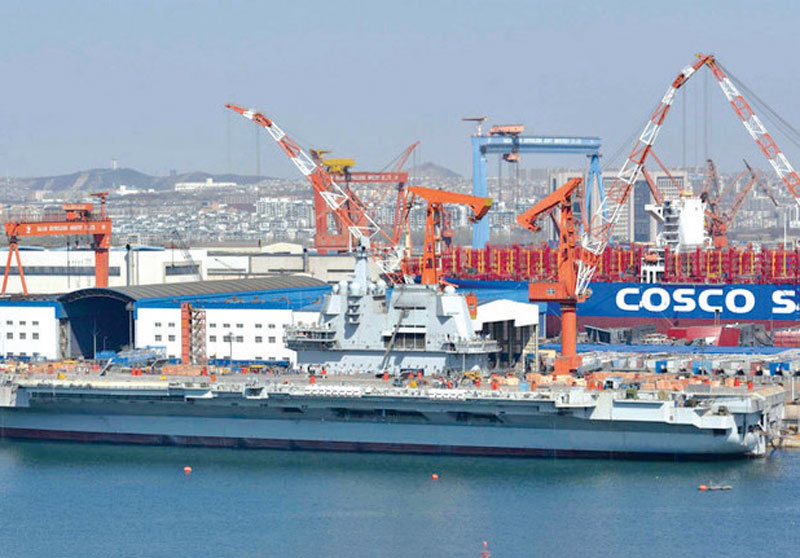With two operational and a third under construction, China is set to realise its ambition of six operational aircraft carriers
Atul Chandra
China now has two aircraft carriers in service, CNS Liaoning and CNS Shandong, which along with the amphibious assault ship CNS Hainan, are operationally deployed with the Peoples Liberation Army Navy (PLAN).

The construction of the PLAN’s third flattop (Type 003) is well advanced. It will be larger than its existing two flattops. Experts estimate that at 80,000 tonnes, it is the largest warship ever built in China. Reports in Chinese media have indicated that the PLAN is looking to operate six aircraft carriers along with their supporting battle groups in the future. China is making rapid strides in military technology and its intention to operate six aircraft carriers coupled with a proven ability to build naval warships at a rapid pace, could see it emerge as second only to the mighty US Navy by the end of this decade.
Gathering Pace
China is not alone in building its aircraft carrier capabilities. Next generation aircraft carrier programmes are now underway in the US, France and South Korea. India’s Indigenous Aircraft Carrier (IAC), in the 40,000 tonne class, is slated to be commissioned as INS Vikrant next year. The construction of the PLAN’s third aircraft carrier is expected to be completed by the Jiangnan Shipyard in Shanghai in 2023.
In its progress report on the PLAN’s Type 003 carrier released in July, the Centre for Strategic & International Studies (CSIS) stated that based on available satellite imagery, ‘construction of the carrier’s flight deck, basic superstructure, and sponsons is nearly complete,’ and that it would be ready for launch later this year. The CSIS report also confirmed key elements of the Type 003 flattop, which is estimated to be nearly 320m long.
The new aircraft carrier’s flight deck will feature three catapult-assisted launch systems and according to the CSIS report, ‘two aircraft elevators appear to be several meters wider than those of its predecessor, the Shandong.’ The Type 003’s island which houses the command center for flight deck operations along with radar and communication equipment also appears to have a smaller footprint compared to the CNS Liaoning and CNS Shandong.
Upgraded Air Power
A new carrier-based fighter aircraft in the Shenyang Aircraft Corporation 5th generation single-engine FC-31 is expected to operate from the Type 003. Recent news reports emerging from China, showed a full-size mock-up of the FC-31 on a full-size aircraft carrier model built on land. The introduction of a stealthy fighter with near 5th generation capabilities on a PLAN aircraft carrier will dramatically upgrade their offensive capability.
The PLAN will also look to operate the FC-31 in close concert with land-based J-20 fighter jets belonging to the Peoples Liberation Army Air Force (PLAAF). The large twin-engine 5th Gen fighter is now being inducted in larger numbers and 15 J-20 stealth fighters took part in a flypast over the skies of Beijing in July during the 100th anniversary celebrations of the Communist Party of China. Prior to this display, the largest J-20 fly past seen in public involved seven aircraft.
The PLAAF inducted another batch of J-20s with the No.1 Aviation Group in June. Along with plans to power the J-20s with indigenously developed WS-10C engines, instead of its current Russian origin powerplants, new uprated engines with Thrust Vector Control (TVC) with 2D TVC nozzles are also in the pipeline. State owned airframer Aviation Industry Corporation of China (AVIC) is also said to be developing a twin-seat version of the J-20. 4th generation Shenyang J-15 carrier-borne fighters, a Chinese derivative of the Sukhoi Su-33 are presently the PLAN’s only carrier borne strike aircraft. The CNS Shandong and CNS Liaoning can carry 36 and 24 Shenyang J-15s respectively. According to Chinese media outlet Global Times, the PLAN has been taking delivery of more J-15s and upgrades are planned for new build aircraft.
The Liaoning is now being used to train PLAN fighter pilots flying J-15s in advanced carrier borne operations. It recently completed a voyage where it was used to train pilots in night flying operations from the carrier deck and resulted in the first batch of PLAN fighter pilot instructors receiving night operations ratings. They will now start training larger numbers of naval aviators on carrier deck operations by night. The PLAN’s first batch of naval aviators graduated with night flying ratings in 2018. During the same voyage, an all-female PLAN crew independently undertook the dispatch of helicopters, including Z-8 and Z-9s on Liaoning for the first time.
The PLAN is also expected to introduce a marinized variant of its new Z-8L utility helicopter, which is China’s first helicopter in the 15-tonne class. According to the Chinese media outlet Global Times, the new Z-8L could serve in all three arms of the Chinese military and also operate from the PLAN’s new Type 075 amphibious assault ships. The Z-8L is a larger variant of the 13-tonne Z-8 utility helicopter, which is based on Aerospatiale’s 321 Super Frelon. The Z-8L’s cabin is apparently similar in size to the Russian Mi-17 helicopter and features self-protection systems such as a Radar Warning Receiver (RWR) and IR decoys.
You must be logged in to view this content.

